child seat AUDI S6 2014 Owner's Guide
[x] Cancel search | Manufacturer: AUDI, Model Year: 2014, Model line: S6, Model: AUDI S6 2014Pages: 304, PDF Size: 76.32 MB
Page 162 of 304
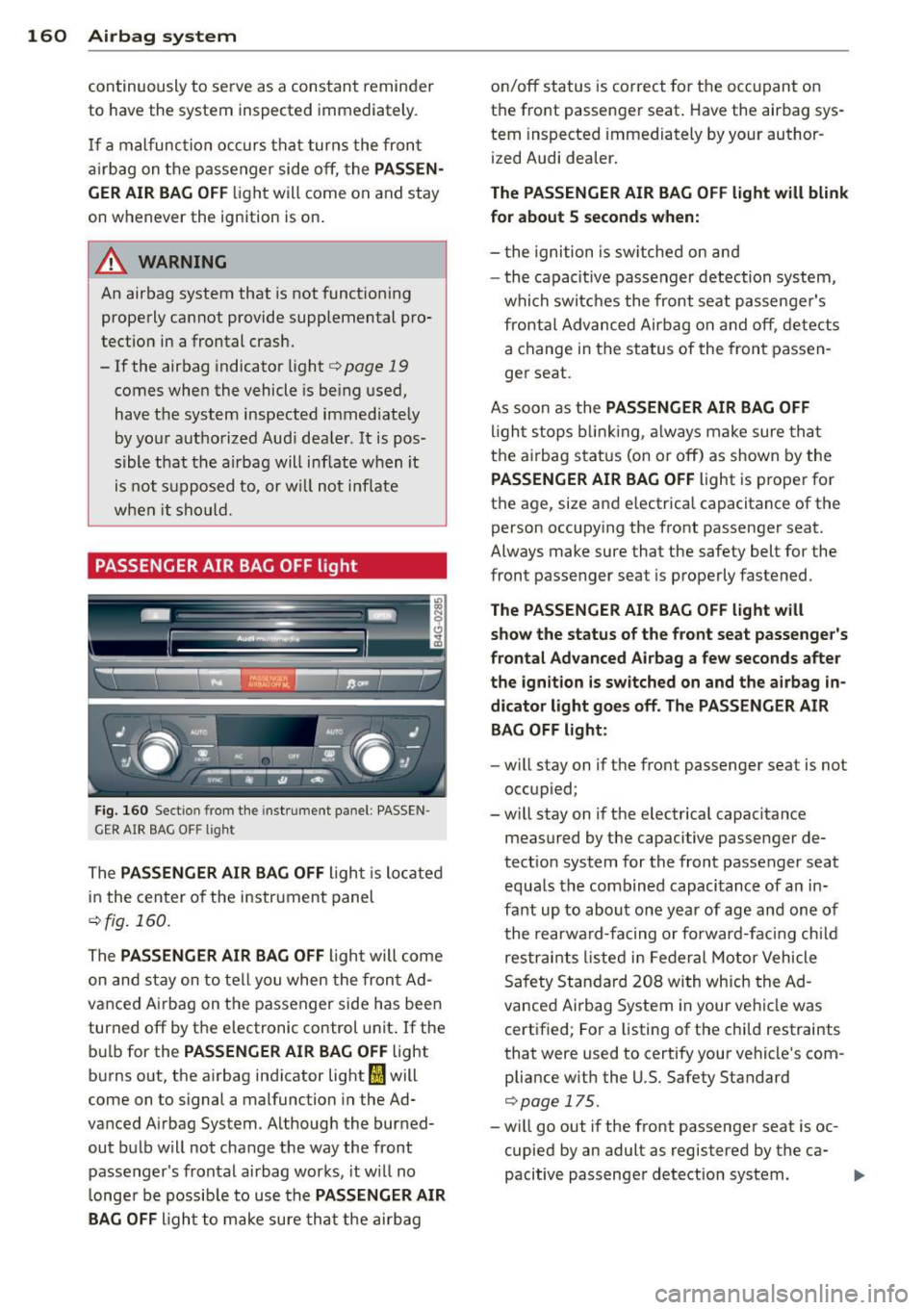
160 Airbag system
continuously to serve as a constant reminder
to have the system inspected immediately.
If a malfunction occurs that turns the front
a ir bag on the passenger side off, the
PAS SEN
GER AIR BA G OFF
light will come on and stay
on whenever the ignition is on .
.&_ WARNING
An airbag system that is not functioning
properly cannot provide supplemental pro
tection in a frontal crash.
- If the airbag indicator light
c::> page 19
comes when the vehicle is be ing used,
have t he system inspected immediately
by your authorized Aud i dea ler . It is pos
sible that the airbag will inf late when it
is not supposed to, or w ill not inflate
when it sho uld.
PASSENGER AIR BAG OFF light
Fig. 160 Section from the inst rument pa nel : PASSEN
GER AIR BAG O FF l ight
The PAS SENGER AIR BAG OFF Light is Located
in the center of the instrument panel
c::> fig . 160.
The PASSENGER AIR BAG OFF Light will come
on and stay on to tell you when the front Ad
vanced A irbag on the passenger side has been
turned off by the e lectronic control unit . If the
bu lb for the
PAS SENGER AIR BAG OFF Light
burns out, the a irbag ind icator light
fl will
come on to signal a malfunction in the Ad·
vanced Airbag System . Although the burned
out bulb will not change the way the front
passenger's frontal airbag works, it w ill no
L onger be possib le to use the
PAS SENGER AIR
BAG OFF
Light to make sure tha t the ai rbag on/off status is correct for the occ
upant on
the front passenger seat . Have the airbag sys
tem inspected immediately by your author
ized Audi dea ler.
The PASSENGER AIR BAG OFF light will blink
for about 5 second s when:
- t he ignition is sw itched on and
- the capacit ive passenger detection system,
which switc hes the front seat passenger's
frontal Advanced Airbag on and off, detects a change in the status of the front passen
ger seat.
As soon as the
PASSENGER AIR BAG OFF
l igh t stops b linking, a lways make sure tha t
the a irbag status (on or off) as shown by the
PAS SENGER AIR BAG OFF Light is proper for
the age, size and e lectrical capacitance of the
person occupy ing the front passenger seat.
Always make sure that the safety belt for the
front passenger seat is properly fastened .
The PASSENGER AIR BAG OF F light will
s ho w the status of the front seat pass enger 's
frontal Ad van ced Air bag a few seconds after
the ign ition is sw itched on and the airbag in
dicator light go es off. The PA SSENG ER AIR
BAG OFF li ght :
-will stay on if the front passenger seat is not
occupied;
- w ill stay on if the e lectrical capacitance
measured by the capacitive passenger de
tect ion system for the front passenger seat
equa ls the combined capacitance of an in
fant up to about one yea r of age and one of
the rearward-facing or forward-fac ing ch ild
restrai nts listed in Federal Motor Vehicle
Safety Standard 208 with which the Ad
vanced Airbag System in your vehicle was
certified; For a Listing of the child restraints
that were used to certify your vehicle's com
pliance with the U.S. Safety Standard
c::>poge 175.
- will go out if the front passenger seat is oc cupied by an adult as registered by the ca
pacitive passenger detection system.
Page 163 of 304
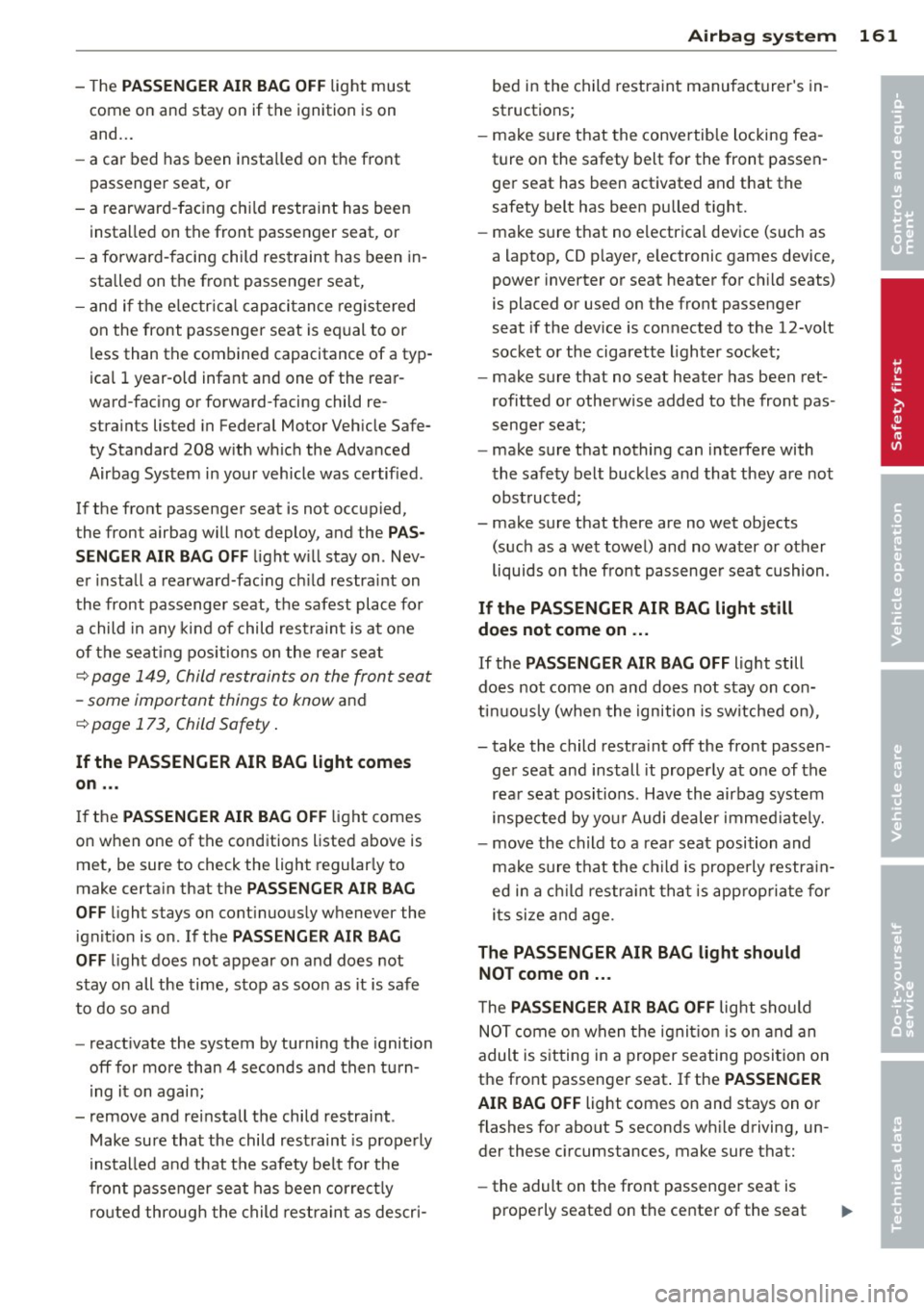
-The PASSENGER AIR BAG OFF light must
come on and stay on if the ignition is on
and . ..
- a car bed has been installed on the front
passenger seat, or
- a rearward -facing chi ld restraint has been
installed on the front passenger seat, or
- a fo rward-facing child restraint has been in
stalled on the front passenger seat,
- and if the e lectr ica l capacitance registered
on the front passenger seat is equal to or
l ess than the combined capacitance of a typ
ical 1 year-old infant and one of the rear
ward-facing or forward -facing child re
straints listed in Federal Motor Vehicle Safe
ty Standard 208 w ith which the Advanced
Airbag System in your vehicle was certified.
If the front passenger seat is not occupied,
the front airbag will not deploy, and the
PAS ·
SENGER AIR BAG OFF
light will stay on . Nev
er install a rearward-facing child restra int on
the front passenger seat, the safest place fo r
a child in any kind of child restraint is at one
of the seating positions on the rear seat
¢ page 149, Child restraints on the front seat
- some important things to know
and
¢ page 173, Child Safety.
If the PASSENGER AIR BAG light comes
on ...
If the PASSENGER AIR BAG OFF light comes
on when one of the conditions listed above is met, be sure to check the light regularly to
make certa in that the
PASSENGER AIR BAG
OFF
light stays on cont inuous ly whenever the
ignition is on.
If the PASSENGER AIR BAG
OFF
light does not appear on and does not
stay on all the time, stop as soon as it is safe
to do so and
- react ivate the system by turning the ignition
off for more than 4 seconds and then turn
i ng it on again;
- remove and reinstall the chi ld restraint .
Make sure that the child restraint is properly
installed and that the safety be lt fo r the
front passenger seat has been correctly
routed through the child rest raint as descri-
Airbag system 161
bed in the child restraint manufacturer's in
structions;
- make sure that the convertible locking fea
ture on the safety belt for the front passen
ger seat has been activated and that the
safety belt has been pulled tight.
- make sure that no e lectrical device (such as
a laptop, CD p layer, e lectronic games device,
power inverter or seat heater for ch ild seats)
is placed or used on the front passenger
seat if the dev ice is connected to the 12-volt
socket or the cigarette l ighter socket;
- make sure that no seat heater has been ret
rofitted or otherwise added to the front pas
senger seat;
- make sure that nothing can interfere with
the safety belt buckles and that they are not
obstructed;
- make sure that there are no wet objects
(such as a wet towel) and no water or other
liquids on the front passenger seat cushion .
If the PASSENGER AIR BAG light still
does not come on ...
If the PASSENGER AIR BAG OFF light still
does not come on and does not stay on con
tinuously (when the ignition is switched on),
- take the child restraint off the front passen-
ger seat and install it properly at one of the
rear seat positions . Have the airbag system
inspected by your Audi dealer immed iate ly.
- move the child to a rear seat position and
make sure that the child is properly restrain
ed in a child restra int that is appropriate for
its size and age.
The PASSENGER AIR BAG light should
NOT come on ...
T he PASSENGER AIR BAG OFF lig ht should
NOT come on when the ignition is on and an
adult is sitting in a proper seating position on
the front passenger seat . If the
PASSENGER
AIR BAG OFF
light comes on and stays on or
flashes for about 5 seconds wh ile driving, un
der these c ircumstances, make sure that:
- the adult on the front passenger seat is
properly seated on the center of the seat
•
•
Page 164 of 304
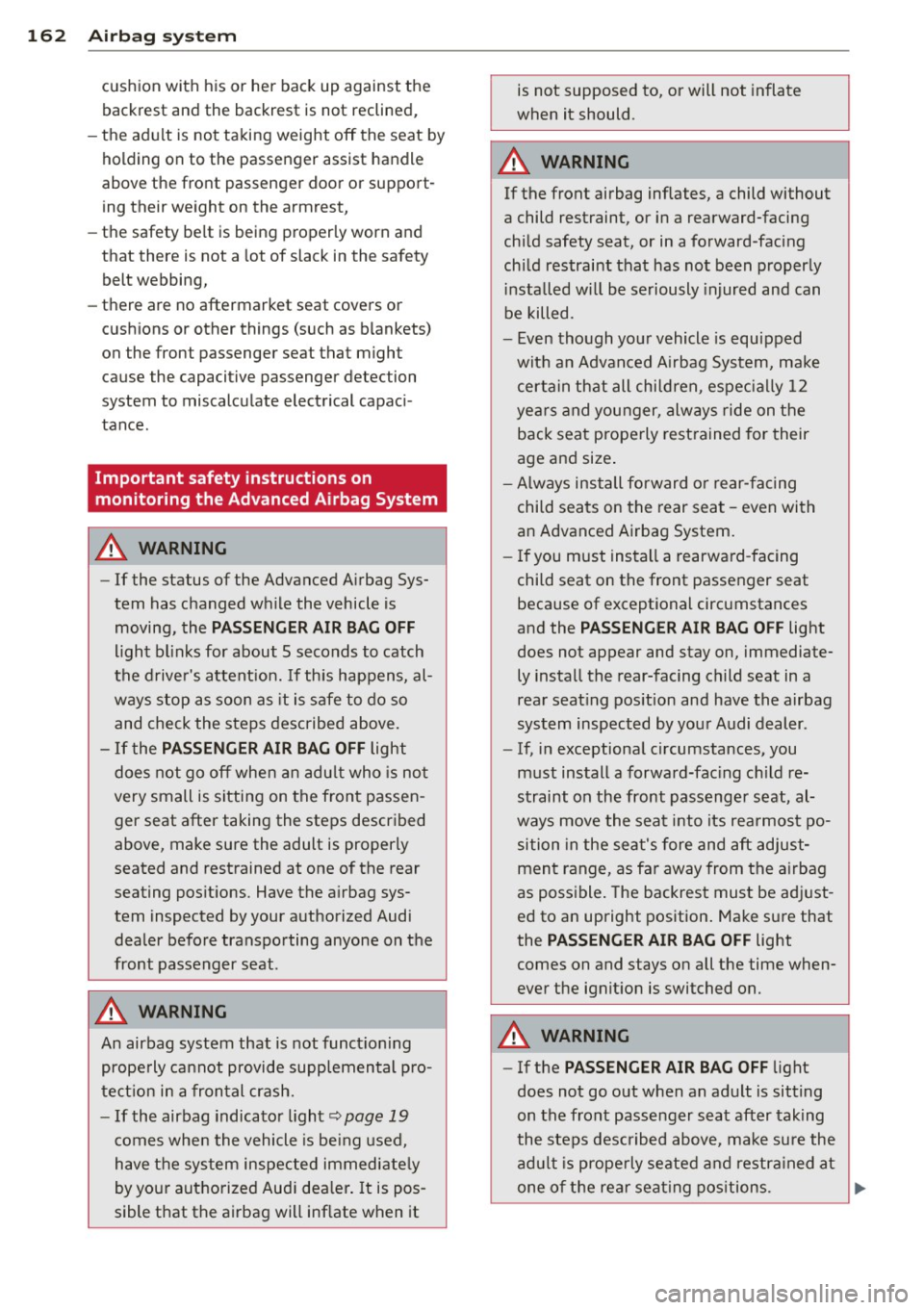
162 Airbag sys tem
cushion wit h his or her back up against the
backrest and the backrest is n ot reclined,
- the adu lt is not taking weight off the seat by
holding on to the passenger assist handle
above the front passenger door or support
ing their weight on the armrest,
- the safety be lt is being properly worn and
that there is not a lot of slack in the safety
belt webbing,
- there are no aftermarket seat covers or
cushions or other things (such as b lankets)
on the front passenger seat that might
cause the capacitive passenger detection
system to miscalculate electrical capac i
tance .
Important safety instructions on
monitoring the Advanced Airbag System
A WARNING
-If the status of the Advanced A irbag Sys
tem has changed wh ile the vehicle is
moving, the
PASSENGER AIR BAG OFF
light blinks for about 5 seconds to catch
the drive r's attent ion.
If this happens, al
ways s top as soon as it is safe to do so
and check the steps described above.
- If the
PASSENGER AIR BAG OFF light
does not go off whe n an adu lt who is no t
very small is sitting on the front passen
ger seat after taking the steps described
above, make sure the adult is properly
seated and restrained at one of the rear
seating pos itions. Have the a irbag sys
tem inspected by your authorized Audi
dealer before transpo rting anyone on the
front passenger seat.
A WARNING , --
An airbag system that is not funct io ning
prope rly cannot provide supplemental p ro
tect ion in a fron tal crash.
- If the airbag indicator light ~ page 19
comes when the vehicle is be ing used,
h ave t he system inspected immedi ate ly
by yo ur authorized Aud i dea ler .
It is pos
sible that the airbag will inflate when it is not supposed to, or will not
inflate
when it should.
A WARNING
-If the front airbag inflates, a child without
a child restraint, or in a rearward-facing
chi ld safety seat, or in a forward -facing
chi ld restraint that has not been proper ly
i nstalled w ill be seriously injured and can
b e killed.
- Even though you r vehicle is equipped
with an Adva nced A irbag System, make
certain that all children, espe cial ly 12
ye ars and you nger, always ride on the
back seat properly rest rained for their
age and size .
- Always inst all forward o r rear-fa cing
child seats on the rear sea t - even with
an Advanced A irbag System.
- If you must ins tall a rearwa rd -facing
child seat on the front passenger seat because of exceptional circumstances
and the
PASSENGER AIR BAG OFF light
does not appear and stay on, immediate
ly install the rear-facing child seat in a
rea r seat ing pos ition and have the airbag
sys tem inspected by you r Audi dealer .
- If, in exceptiona l circumstances, you
m ust install a forward-fac ing c hild re
straint on the front passenger seat, al
ways move the seat into its rearmos t po
sition in the se at's fore and aft adjust
men t range, as far away from the a irbag
as poss ible . The backrest mus t be ad just
ed to an upright pos ition . Make su re that
the
PASSENGER AIR BAG OFF light
comes on and stays on all the time when
ever the ignit ion is switched on.
A WARNING
-
- If the PASSENGER AIR BAG OFF light
does not go out when an adult is sitting
on the front passe nger seat after taking
the steps described above, make su re the
adu lt is prope rly seated a nd restra ined at
one o f the rea r seat ing pos itions.
~
Page 168 of 304
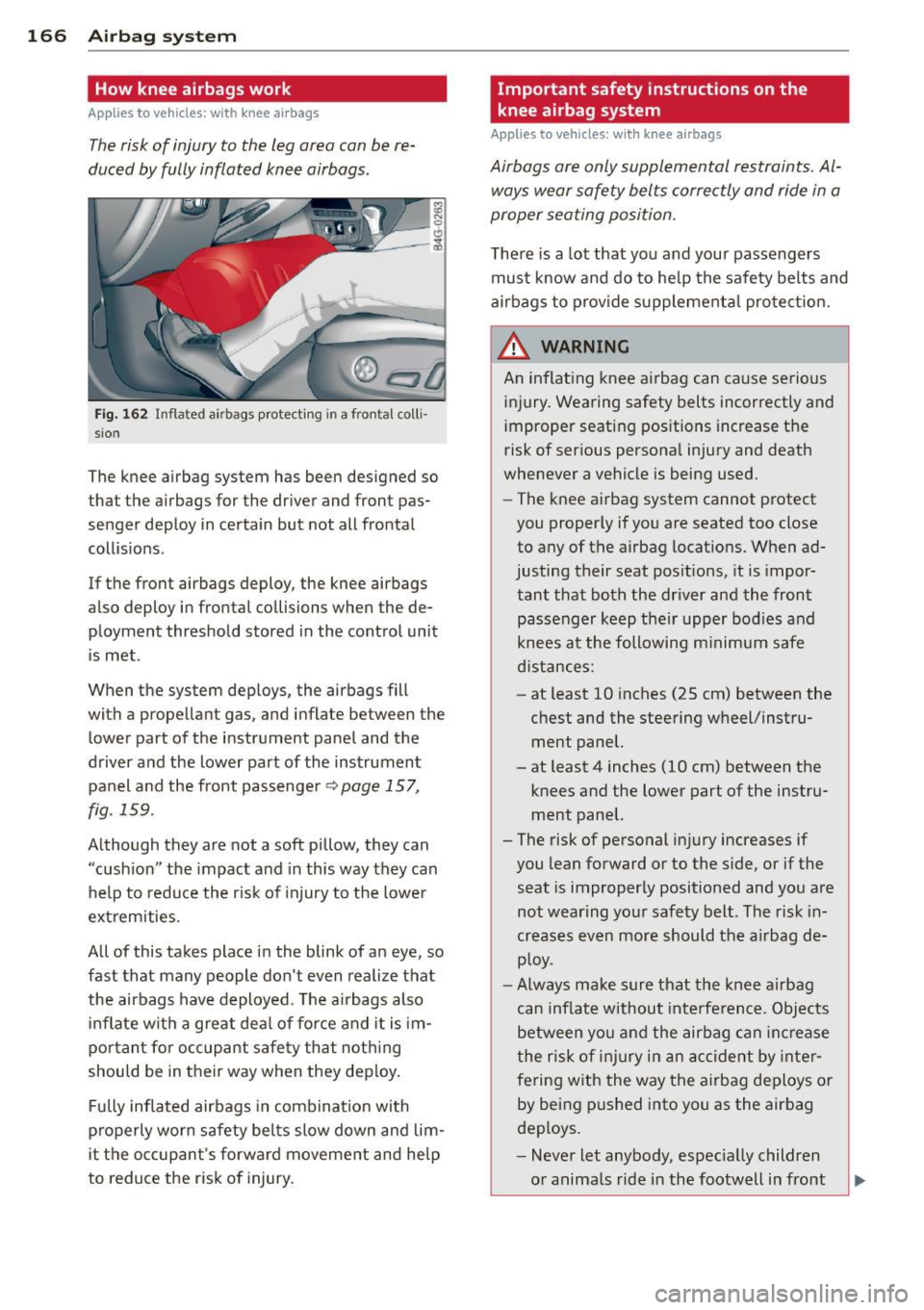
166 Airbag system
How knee airbags work
Applies to vehicles: with knee airbags
The risk of injury to the leg area can be re
duced by fully inflated knee airbags.
Fig. 162 Inflated airbags protecting in a frontal colli·
s io n
The knee airbag system has been designed so
that the a irbags for the driver and front pas
senger deploy in certain but not all frontal
collisions.
If the front airbags deploy, the knee airbags
a lso deploy in frontal collisions when the de
ployment threshold stored in the control unit
is met .
When the system deploys, the airbags fill
with a propellant gas, and inflate between the
lower part of the instrument panel and the
driver and the lower part of the instrument
panel and the front passenger
Q page 157,
fig . 159.
Although they are not a soft pillow, they can
"cush ion" the impact and in this way they can
help to reduce the risk of injury to the lower
extremities.
All of this takes place in the blink of an eye, so
fast that many people don't even realize that
the airbags have deployed . The airbags also
inflate with a great deal of force and it is im
portant for occupant safety that nothing
should be in their way when they deploy.
Fully inflated airbags in combination with
properly worn safety belts slow down and lim
it the occupant's forward movement and help
to reduce the risk of injury. Important safety instructions on the
knee airbag system
Applies
to vehicles: with knee airbags
Airbags are only supplemental restraints. Al
ways wear safety belts correctly and ride in a
proper seating position .
There is a lot that you and your passengers
must know and do to help the safety belts and
airbags to provide supplemental protection.
A WARNING
-An inflating knee airbag can cause serious injury. Wearing safety belts incorrectly and
improper seating positions increase the
risk of serious personal injury and death
whenever a vehicle is being used.
- The knee airbag system cannot protect
you properly if you are seated too close
to any of the airbag locations. When ad
justing their seat positions, it is impor
tant that both the driver and the front passenger keep their upper bodies and
knees at the following minimum safe
distances:
- at least 10 inches (25 cm) between the
chest and the steering wheel/instru
ment panel.
- at least 4 inches (10 cm) between the knees and the lower part of the instru
ment panel.
- The risk of personal injury increases if
you lean forward or to the side, or if the
seat is improperly positioned and you are
not wearing your safety belt . The risk in
creases even more should the airbag de
ploy .
- Always make sure that the knee airbag
can inflate without interference. Objects
between you and the airbag can increase
the risk of injury in an accident by inter
fering with the way the airbag deploys or
by being pushed into you as the airbag
deploys.
- Never let anybody, especially children
or animals ride in the footwell in front
Page 169 of 304
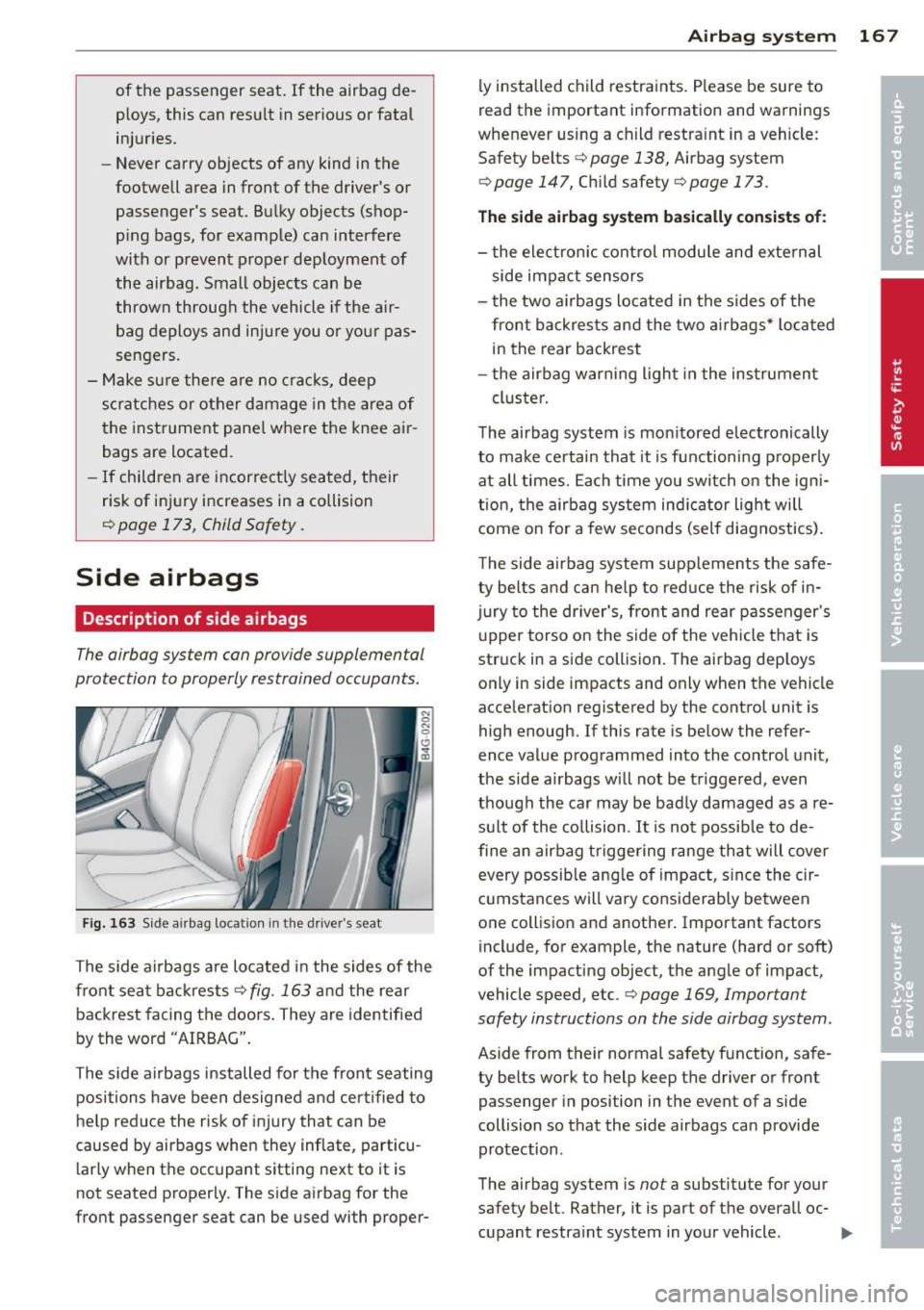
of the passenger seat. If the airbag de
p loys, this can resu lt in serious or fata l
injuries.
- Never carry objects of any kind in the
footwell area in front of the driver's or passenger's seat. Bulky objects (shop
p ing bags, for e xample) ca n interfere
with or prevent proper dep loyment of
the airbag . Small objects can be
thrown throug h the vehicle if the ai r
b ag deploys and injure you o r yo ur pas
sengers.
- Make su re there are no crac ks, deep
scratches or other damage in the area of
the instrument pane l where the knee air
bags are located.
- If children are incorrect ly sea ted, their
risk of i njury increases in a collision
¢ page 173, Child Safety .
Side airbags
Description of side airbags
The airbag system can provide supplemental
protection to properly restrained occupants .
Fig . 163 Side a irbag loca tion in t he d river 's s eat
The side a irbags a re located i n the sides of the
front seat ba ckrests
¢fig . 163 a nd the rear
backrest facing the doors. They are identified
bytheword "AIRBAG" .
The side a irbags installed for the front seating
positions have been designed and cer tified to
he lp red uce the risk of i nju ry that can be
caused by airbags when they inflate, particu
l arly when the occupant sitting next to it is
not seated proper ly . The side airbag for the
front passenger seat can be used with proper-
A irba g sy stem 16 7
ly installed child restra ints . Please be sure to
read the important informat ion and warnings
whenever using a child restra int in a vehicle:
Safety belts ¢
page 138, Airbag system
c>page 147, Chi ld safety c> page 173.
The side airbag sy stem basically consi st s of:
- t he electro nic cont ro l modu le and external
side impact sensors
- t he two a irbags located in the s ides of the
front backrests and the two a irbags* loc ated
in the rear backrest
- t he airbag warning light in the ins trumen t
cl uste r.
T he airbag system is mon itored e lec tronically
to make ce rtain that it is f unction ing p roperly
at all times. Each time you sw itch o n the igni
tion, the airbag system ind icator light will
come on for a few seconds (self diagnostics) .
T he side airbag system supplements the safe
t y bel ts a nd can help to red uce the risk of in
j u ry to the dr iver's, fron t and re ar passenger's
u pper torso on the side of the veh icle t hat is
str uck in a side collision . The airbag dep loys
only in side impacts and only when the vehicle
acce lerat ion reg istered by the control unit is
high enough. If this rate is below the refer
ence value prog rammed into the co ntrol unit,
the side ai rbags w ill not be triggered, even
though the car may be bad ly damaged as a re
su lt of the co llision .
It is not possib le to de
fine an airbag triggering range that will cover every possib le ang le of impact, s in ce the cir
cumstances will vary considerably be tween
one collisio n and another . Important factors
include, for example , the nature (hard or soft)
of the impacting objec t, the angle of impact,
vehicle speed, etc .
¢ page 169, Impor tan t
safety instructions on the side airbag system .
Aside from their normal safety function, safe
ty belts work to help keep the driver or front passenger in position in the event of a side
collision so that the side airbags can provide protection .
The airbag system is
no t a substitute for your
safety belt. Ra ther, it is part of the overall oc-
cupant restra int system in your vehicle .
IIJJ,
Page 170 of 304
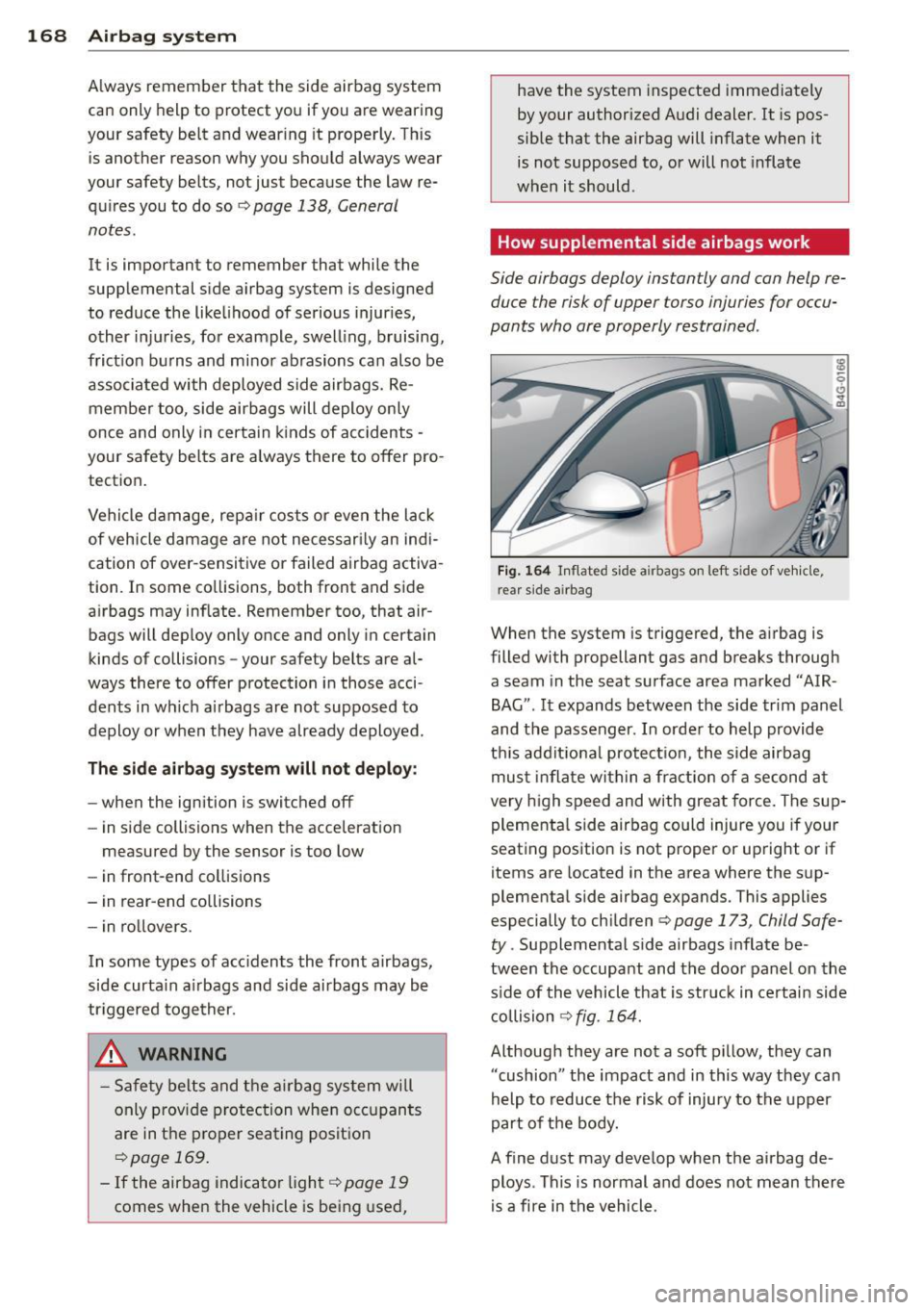
168 Airbag system
Always remember that the side airbag system
can only help to protect you if you are wearing
your safety belt and wearing it properly. This
is another reason w hy you should always wear
your safety belts, not just because the law re
quires you to do so
Q page 138, General
notes.
It is important to remember that while the
supplemental side airbag system is designed
to reduce the likelihood of serious injuries,
other injuries, for example, swelling, bruising,
friction burns and minor abrasions can also be
associated with deployed side airbags. Remember too, side airbags will deploy only
once and only in certain kinds of accidents -
your safety belts are always there to offer pro
tection .
Vehicle damage, repair costs or even the lack
of vehicle damage are not necessarily an indi
cation of over-sensitive or failed airbag activa
tion. In some collisions, both front and side
airbags may inflate. Remember too, that air
bags will deploy only once and only in certain
kinds of collisions -your safety belts are al
ways there to offer protection in those acci
dents in which airbags are not supposed to
deploy or when they have already deployed.
The side airbag system will not deploy:
- when the ign ition is switched off
- in side collisions when the acceleration
measured by the sensor is too low
- in front-end collisions
- in rear-end collisions
- in rollovers.
In some types of accidents the front airbags,
side curtain airbags and side airbags may be
triggered together.
.&_ WARNING
- Safety belts and the airbag system will
only provide protection when occupants
are in the proper seating position
Qpoge 169.
- If the airbag indicator light Q page 19
comes when the vehicle is being used,
-
have the system inspected immediately
by your authorized Audi dealer. It is pos
sible that the airbag will inflate when it
is not supposed to, or will not inflate
when it should.
How supplemental side airbags work
Side airbags deploy instantly and can help re
duce the risk of upper torso injuries for occu
pants who are properly restrained .
Fig. 164 Inflated side airbags on left s ide of vehicle ,
rear side a irbag
When the system is triggered, the airbag is
filled with propellant gas and breaks through
a seam in the seat surface area marked "AIR
BAG".
It expands between the side trim panel
and the passenger. In order to help provide
this additional protection, the side airbag must inflate within a fraction of a second at
very high speed and with great force. The sup
plemental side airbag could injure you if your
seating position is not proper or upright or if
items are located in the area where the sup
plemental side airbag expands. This applies
especially to children
Q page 173, Child Safe
ty .
Supplemental side airbags inflate be
tween the occupant and the door panel on the side of the vehicle that is struck in certain side
collision
Q fig. 164 .
Although they are not a soft pillow, they can "cushion" the impact and in this way they can
help to reduce the risk of injury to the upper
part of the body.
A fine dust may develop when the airbag de ploys . This is normal and does not mean there
is a fire in the vehicle.
Page 171 of 304
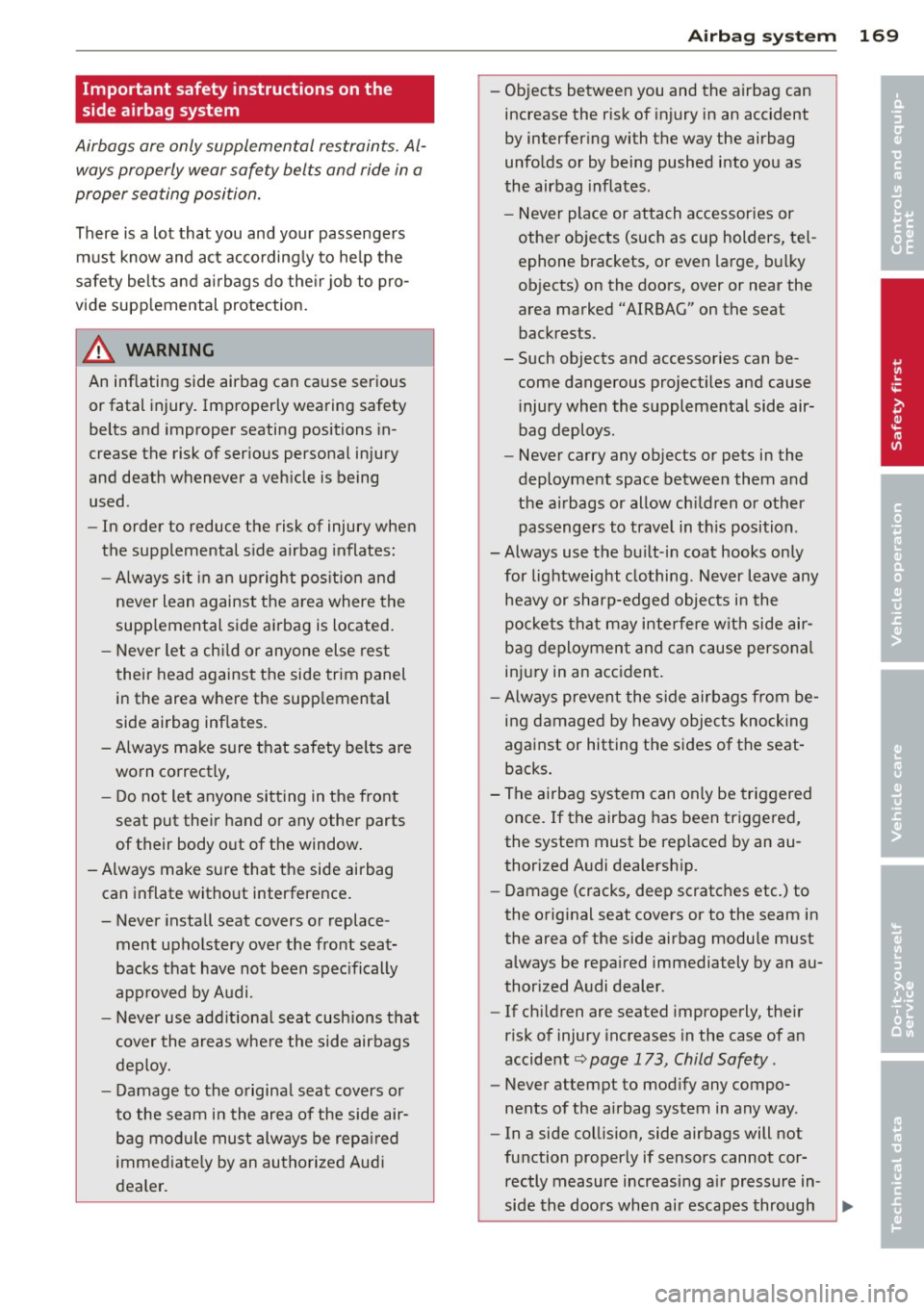
Important safety instructions on the
side airbag system
Airbags are only supplemental restraints. Al
ways properly wear safety belts and ride in a
proper seating position.
There is a lot that you and your passengers
must know and act accordingly to help the
safety belts and airbags do their job to pro
vide supplemental protection .
A WARNING
An inflating side airbag can cause serious
or fatal injury. Improperly wearing safety
belts and improper seating positions in
crease the risk of serious personal injury
and death whenever a vehicle is being
used .
- In order to reduce the risk of injury when
the supplemental side airbag inflates:
-Always sit in an upright position and
never lean against the area where the
supplemental side airbag is located.
- Never let a child or anyone else rest
their head against the side trim panel
in the area where the supplemental
side airbag inflates.
- Always make sure that safety belts are worn correctly,
- Do not let anyone sitting in the front
seat put their hand or any other parts
of their body out of the window.
- Always make sure that the side airbag can inflate without interference.
- Never install seat covers or replace
ment upholstery over the front seat
backs that have not been specifically
approved by Audi.
- Never use additional seat cushions that
cover the areas where the side airbags
deploy.
- Damage to the original seat covers or
to the seam in the area of the side air bag module must always be repaired
immediately by an authorized Audi
dealer.
Airbag system 169
- Objects between you and the airbag can
increase the risk of injury in an accident
by interfering with the way the airbag
unfolds or by being pushed into you as
the airbag inflates.
- Never place or attach accessories or
other objects (such as cup holders, tel
ephone brackets, or even large, bulky
objects) on the doors, over or near the
area marked "AIRBAG" on the seat backrests .
- Such objects and accessories can be come dangerous projectiles and cause
injury when the supplemental side air
bag deploys.
- Never carry any objects or pets in the
deployment space between them and
the airbags or allow children or other passengers to travel in this position .
- Always use the built -in coat hooks only
for lightweight clothing . Never leave any
heavy or sharp-edged objects in the
pockets that may interfere with side air
bag deployment and can cause personal
injury in an accident.
- Always prevent the side airbags from be
ing damaged by heavy objects knocking
against or hitting the sides of the seat
backs.
- The airbag system can only be triggered
once. If the airbag has been triggered,
the system must be replaced by an au
thorized Audi dealership.
- Damage (cracks, deep scratches etc .) to
the original seat covers or to the seam in
the area of the side airbag module must always be repaired immediately by an au
thorized Audi dealer .
- If children are seated improperly, their
risk of injury increases in the case of an
accident ~
page 173, Child Safety .
-Never attempt to modify any compo
nents of the airbag system in any way .
- In a side collision, side airbags will not
function properly if sensors cannot cor rectly measure increasing air pressure in-
side the doors when air escapes through .,.. •
•
Page 175 of 304
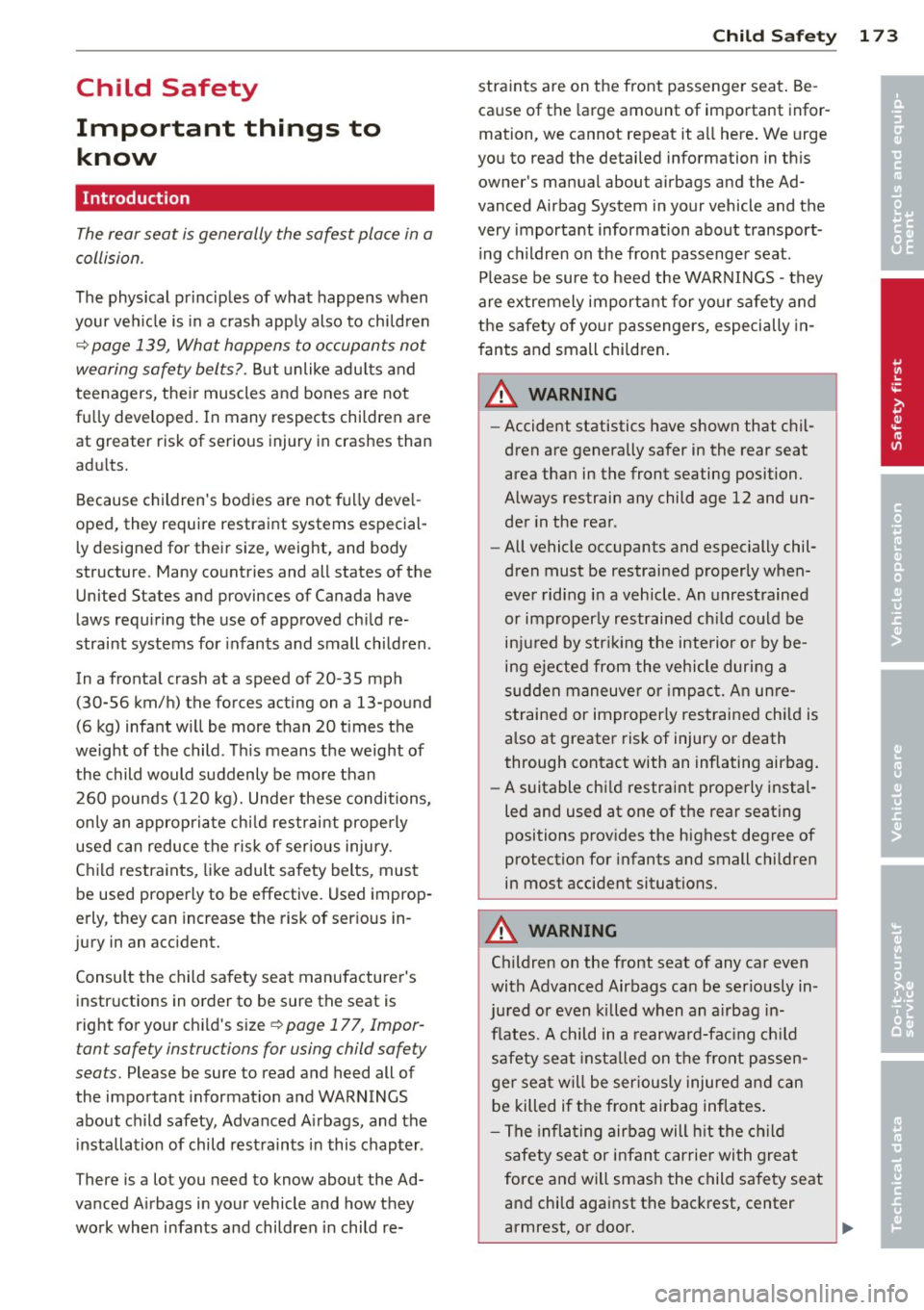
Child Safety
Important things to know
Introduction
The rear seat is generally the safest place in a
collision .
The physical principles of what happens when
your veh icle is in a crash app ly also to chi ldren
~ page 139, What happens to occupants not
wearing safety belts? .
But unlike adults and
teenagers, their muscles and bones are not
fu lly developed. In many respects children are
at greater risk of serious injury in crashes than
adu lts.
Because children's bod ies are not fully deve l
oped, they require restraint systems especial ly designed for their size, weight, and body
structure. Many countries and all states of the
United States and provinces of Canada have
laws requiring the use of approved child re
straint systems for infants and small children .
In a fronta l crash at a speed of 20 -35 mph
(30-56 km/h) the forces acting on a 13-pound
(6 kg) infant w ill be more than 20 t imes the
weight of the child . This means the weight of
the child would suddenly be more than
260 pounds (120 kg). Under these conditions,
on ly an appropriate chi ld restraint properly
used can reduce the risk of ser ious injury .
Child restraints, like adult safety belts, must
be used properly to be effective. Used improp
erly, they can increase the risk of serious in
jury in an accident.
Consult the child safety seat manufacturer's
instructions in order to be sure the seat is
right for your chi ld's size ~
page 177, Impor
tant safety instructions for using child safety
seats.
Please be sure to read and heed all of
the important information and WARNINGS
about ch ild safety, Advanced A irbags, and the
installation of child restraints in this chapter.
There is a lot you need to know about the Ad
vanced Airbags in your vehicle and how they work when infants and children in child re-
Child Sa fet y 173
straints are on the front passenger seat . Be
cause of the large amount of important infor
mation, we cannot repeat it a ll here . We urge
you to read the detailed information in this owner's manual about airbags and the Ad
vanced Airbag System in your vehicle and the
very important information about transport
ing children on the front passenger seat .
Please be sure to heed the WARNINGS -they
are extremely important for your safety and
the safety of your passengers, especially in
fants and small chi ldren .
.A, WARNING
-Accident statistics have shown that chil
dren are generally safer in the rear seat
area than in the front seating position.
Always restrain any child age 12 and un der in the rear.
- All vehicle occupants and especially chil
dren must be restrained properly when
ever riding in a vehicle . An unrestrained
or improperly restrained chi ld could be
injured by str ikin g the interior or by be
ing ejected from the vehicle during a
sudden maneuver or impact. An un re
strained or improper ly restrained chi ld is
also at greater risk of injury or death
through contact with an inflating airbag.
- A suitable chi ld restraint properly instal
led and used at one of the rear seating
positions provides the highest degree of
protection for infants and small children
in most accident situations.
A WARNING
Children on the front seat of any car even
with Advanced Airbags can be ser iously in
jured or even killed when an a irbag in
flates. A child in a rearward-fac ing ch ild
safety seat installed on the front passen
ger seat will be ser iously injured and can
be killed if the front airbag inflates .
- The inflating airbag will h it the child
safety seat or infant carrier with great
force and will smash the child safety seat
and child against the backrest, center
armrest, or door.
•
•
Page 176 of 304
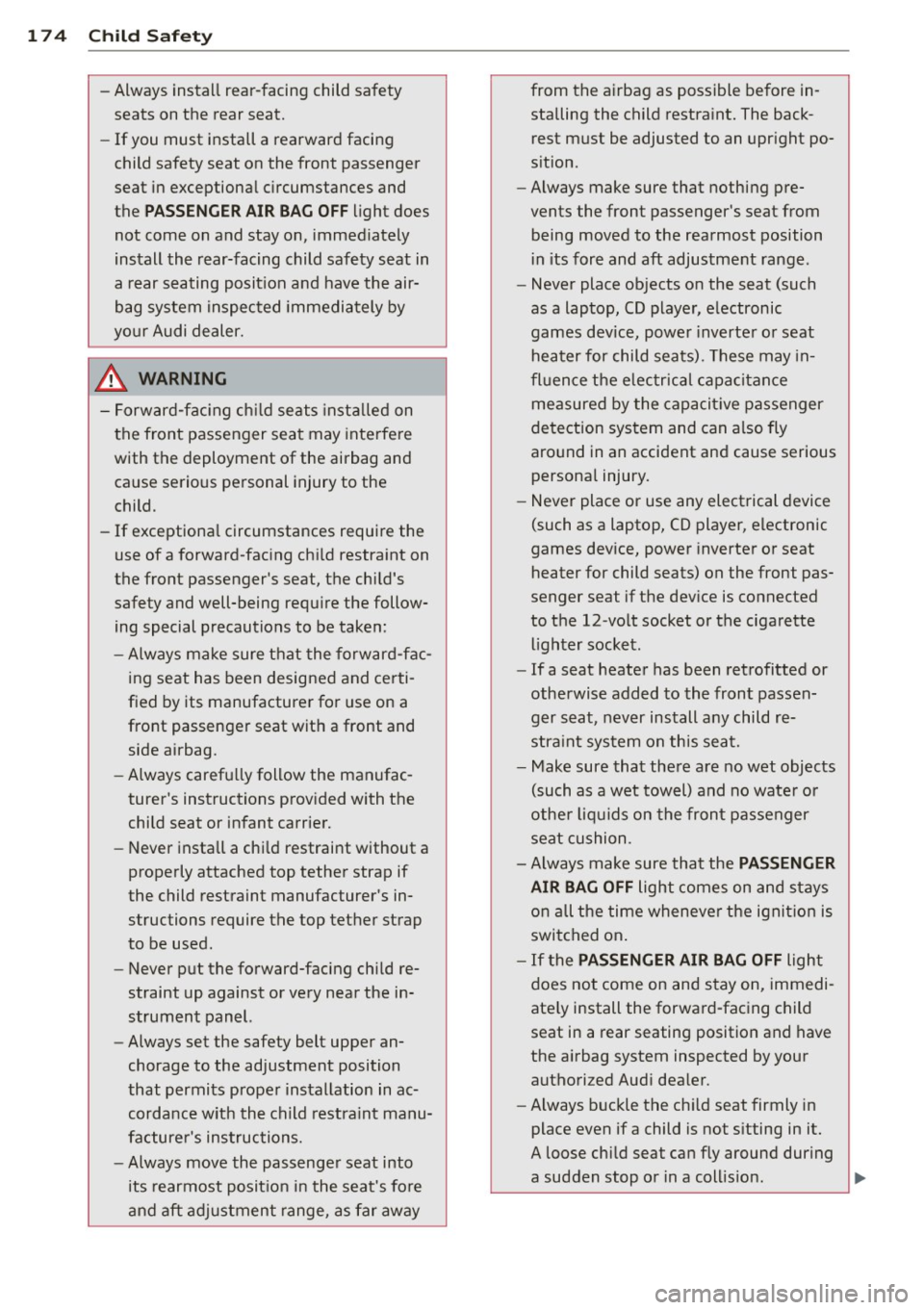
174 Child Safety
-Always install rear-facing child safety
seats on the rear seat.
- If you must install a rearward facing
child safety seat on the front passenger
seat in exceptional circumstances and
the
PASSENGER AIR BAG OFF light does
not come on and stay on, immediately
install the rear-facing child safety seat in
a rear seating position and have the air
bag system inspected immediately by
your Audi dealer.
_&, WARNING
- Forward-facing child seats installed on
the front passenger seat may interfere
with the deployment of the airbag and
cause serious personal injury to the
child.
- If exceptional circumstances require the
use of a forward-facing child restraint on
the front passenger 's seat, the child's
safety and well-being require the follow ing special precautions to be taken:
- Always make sure that the forward-fac
ing seat has been designed and certi
fied by its manufacturer for use on a
front passenger seat with a front and
side airbag.
- Always carefully follow the manufac
turer's instructions provided with the
child seat or infant carrier.
- Never install a child restraint without a
properly attached top tether strap if
the child restraint manufacturer's in
structions require the top tether strap
to be used.
- Never put the forward-facing child re
straint up against or very near the in
strument panel.
- Always set the safety belt upper an
chorage to the adjustment position
that permits proper installation in ac
cordance with the child restraint manu
facturer's instructions.
-Always move the passenger seat into
its rearmost position in the seat's fore
and aft adjustment range, as far away
.
from the airbag as possible before in
stalling the child restraint. The back
rest must be adjusted to an upright po
sition .
- Always make sure that nothing pre
vents the front passenger's seat from
being moved to the rearmost position
in its fore and aft adjustment range.
- Never place objects on the seat (such
as a laptop, CD player, electronic
games device, power inverter or seat
heater for child seats) . These may in
fluence the electrical capacitance
measured by the capacitive passenger
detection system and can also fly
around in an accident and cause serious
personal injury.
- Never place or use any electrical device
(such as a laptop, CD player, electronic
games device, power inverter or seat
heater for child seats) on the front pas
senger seat if the device is connected
to the 12 -volt socket or the cigarette
lighter socket.
- If a seat heater has been retrofitted or
otherwise added to the front passen
ger seat, never install any child re
straint system on this seat.
- Make sure that there are no wet objects
(such as a wet towel) and no water or
other liquids on the front passenger
seat cushion .
- Always make sure that the
PASSENGER
AIR BAG OFF
light comes on and stays
on all the time whenever the ignition is
switched on.
- If the PASSENGER AIR BAG OFF light
does not come on and stay on, immedi
ately install the forward-facing child seat in a rear seating position and have
the airbag system inspected by your
authori zed Audi dealer.
- Always buckle the child seat firmly in
place even if a child is not sitting in it.
A loose child seat can fly around during
a sudden stop or in a collision.
~
Page 177 of 304
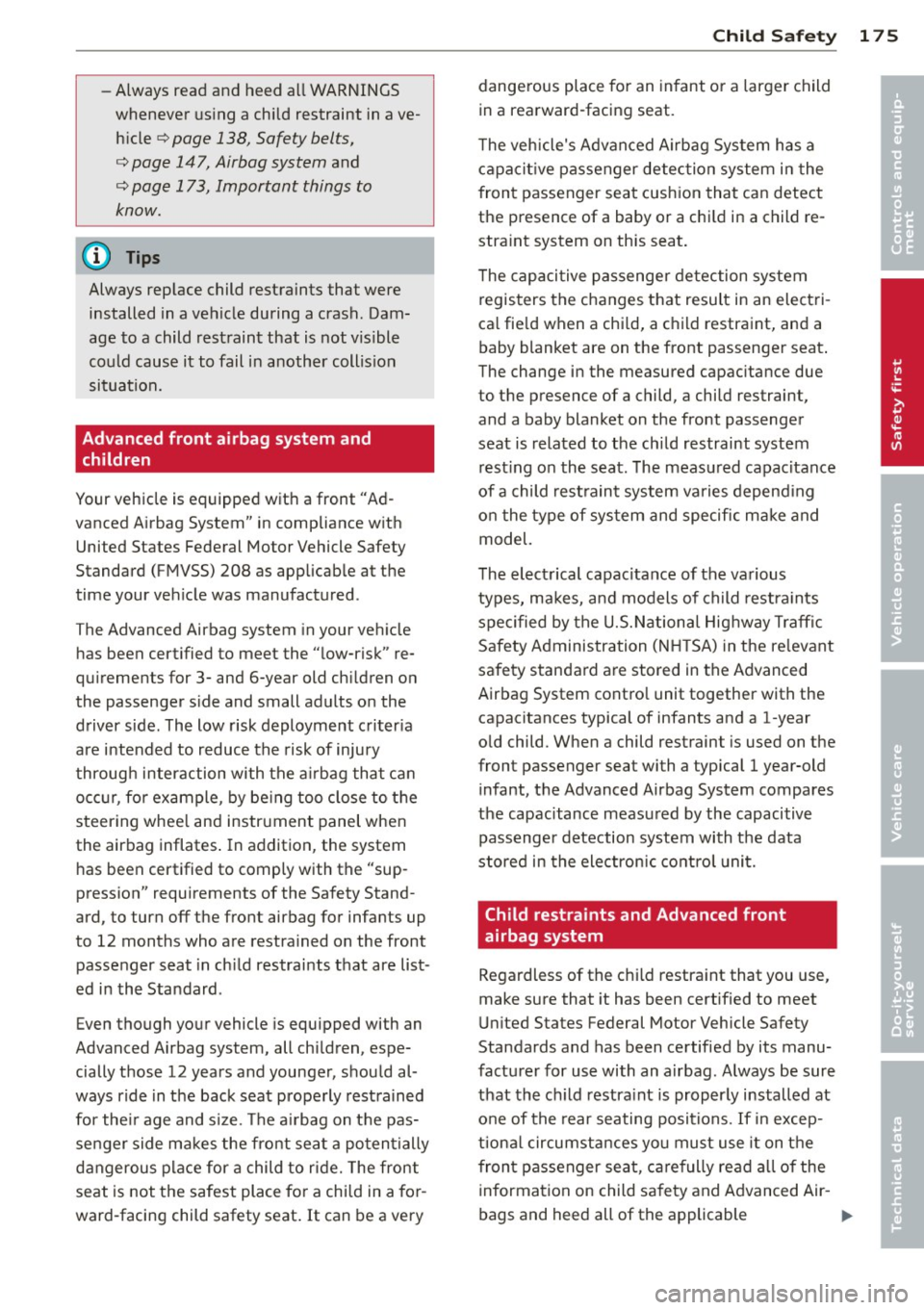
-Always read and heed a ll WARNINGS
whenever using a child restraint in ave
h icle
¢ page 138, Safety belts,
¢ page 147, Airbag system and
¢ page 173, Important things to
know.
(D Tips
Always replace child restraints that were
installed in a vehicle during a crash. Dam
age to a child rest raint that is not vis ible
could cause it to fail in another collis ion
situation.
Advanced front airbag system and children
Your vehicle is eq uipped with a front "Ad
vanced Airbag System" in compliance w ith
United States Federal Motor Vehicle Safety
Standard (FMVSS) 208 as applicable at the
time your veh icle was manufactured .
T he Advanced Airbag system in your vehicle
has been certified to meet the "low-risk" re
qu irements for 3-and 6-year old ch ildren on
the passenger s ide and small adults o n the
driver side. The low risk deployment criter ia
a re i ntended to reduce the risk of inju ry
through interaction with the a irbag that can
oc cu r, fo r example , by be ing too close to the
steering whee l and instrument panel when
the airbag inflates . In addition, the system
has been certified to comply with the "sup
press ion" requirements of the Safety Stand
ard, to turn off the front airbag for infants up
to 12 months who are restra ined on the front
passenger seat in ch ild restraints that are list
ed i n the Standard .
Even though your vehicle is equipped with an
Advanced Airbag system, all chi ldren, espe
cially those 12 years and younger, shou ld al
ways ride in t he back seat properly rest ra ined
fo r the ir age and s ize. Th e a irbag on t he pas
senger side makes the fro nt seat a poten tially
d a ngerous pla ce for a child to ride. The front
seat is not the safest place fo r a child in a fo r
ward-facing child safety seat . It can be a very
Child Sa fet y 175
dange rous place fo r an infant o r a larger child
in a rearward-facing seat.
T he veh icle's Advan ced Ai rb ag Sys tem has a
capacit ive passenger detec tion system in the
front passenger seat cush ion that can detect
the presence of a baby or a c hild in a child re
stra int system on this seat .
T he capaci tive passenge r detection system
r egisters the changes that result in an electri
ca l fie ld when a chi ld, a ch ild restraint, and a
baby blanket are on the front passenger seat .
The change in the measured capac itance due
to the presence of a child, a child restraint,
and a baby blanket on the front passenger
seat is related to the ch ild restraint system
rest ing on the seat . The meas ured capacitance
of a child res traint system va ries depend ing
o n the type of sys tem and specific m ake and
model.
T he elect rical capac itance of the va rious
types, ma kes, a nd models of child restra ints
spe cified by the U.S. Nationa l Highway Traff ic
Safety Administra tion (N HTSA) in the re levant
sa fety standard are stored in the Advanced
Airbag System contro l unit together with the
capacitances typical of infants and a 1-year
o ld child. W hen a child restraint is used on t he
front passenger seat with a typica l 1 year-old
infant, t he Advanced Airbag System compares
the capacitance measu red by the capacitive
passenger detection system with the data
s tored in the ele ctronic co ntrol unit.
Child restraints and Advanced front
airbag system
Rega rdless of the c hild restraint that you use,
make sure that it has been certified to meet
U nited States Federal Motor Vehicle Safety
Standards and has been certified by its manu
facturer for use with an airbag. A lways be sure
that the c hild restra int is properly installed at
o ne of the rear seating positions. If in excep
t iona l circumsta nces yo u must use it on the
fron t passenger sea t, ca re fully read all of the
i nformation on child sa fe ty and Advanced Air -
bags and heed all of the applicable ..,.
•
•